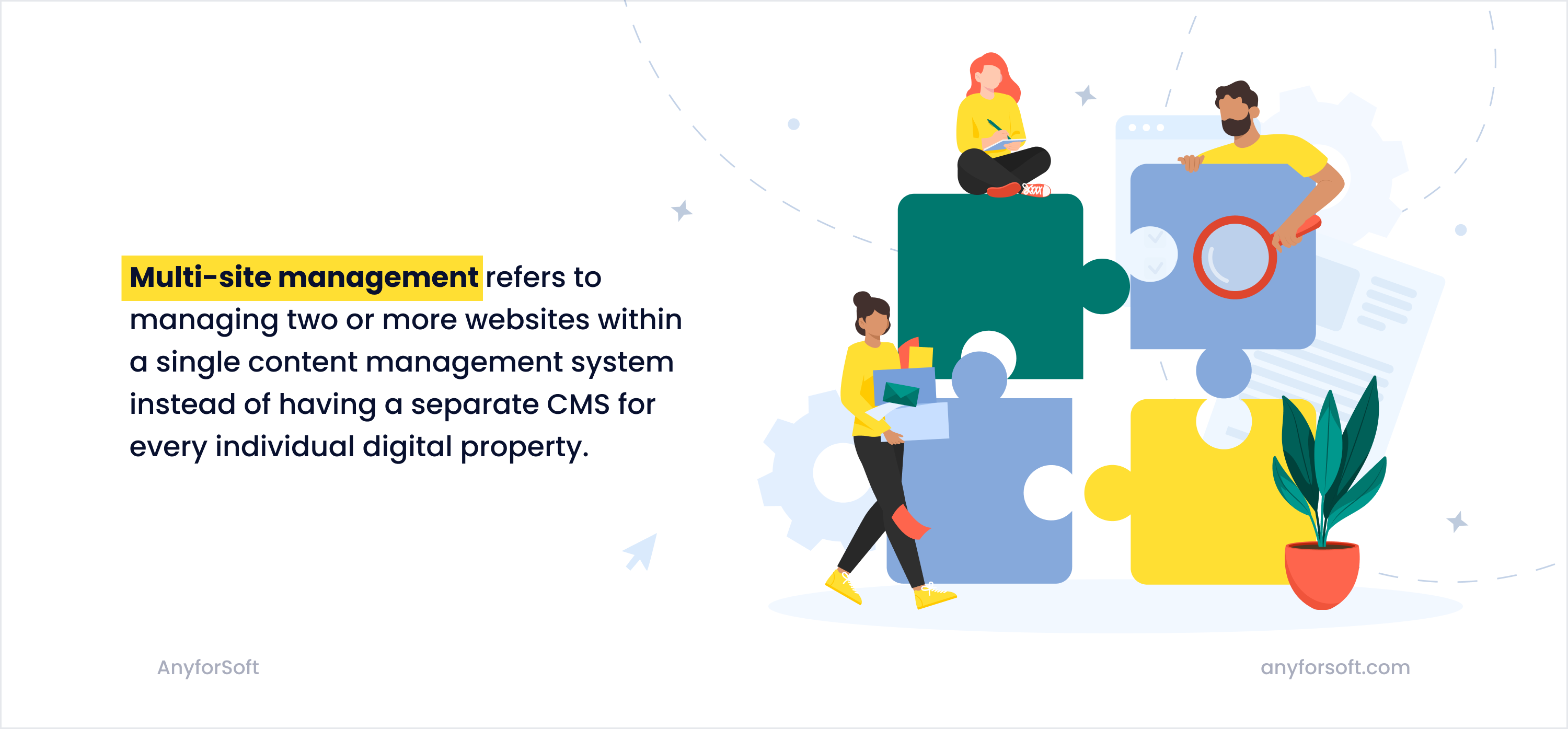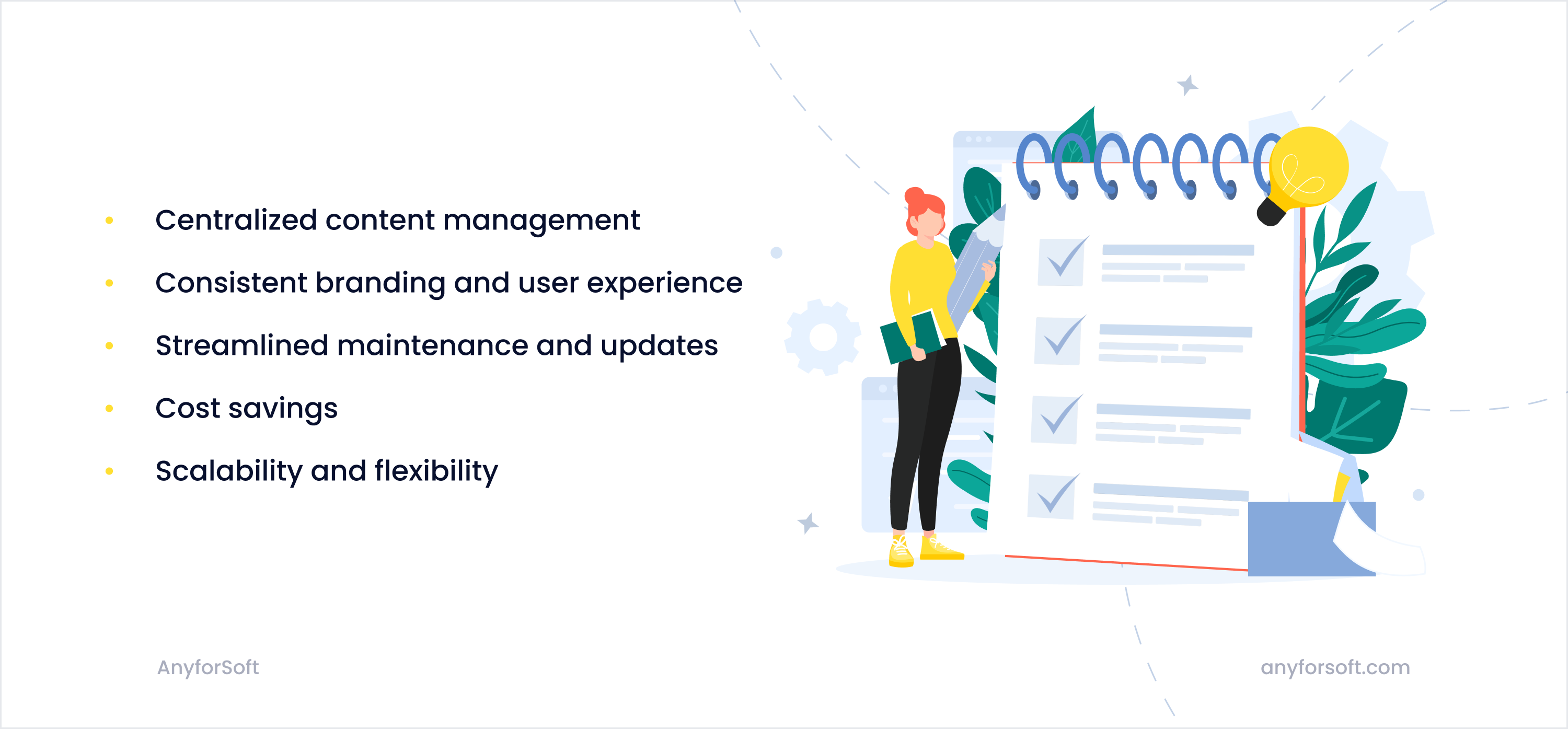According to WP Engine’s survey, 60% of enterprises use at least two CMSs. In other words, they manage more than one site.
Organizations need multiple websites for various reasons, from localizing content to specific countries to introducing new unique brands or product lines. Many have a broad audience they have to cater to, and having several resources helps them deliver personalized content for each target user group and market segment.
However, managing multiple websites with the “one CMS for one website” approach is inconvenient. Switching between different CMSs to update content on each site is time-consuming and daunting, each CMS has its own learning curve and requires specific skills to operate effectively, and when you rely on different platforms, it’s hard to provide a consistent digital experience across all your sites. Also, let’s not forget about maintenance and support costs, which in this case are astronomical.
Luckily, there is an easy way to solve this multi-site management problem. And the solution is a headless content management system. With a headless CMS, you can maintain multiple websites within a single platform, which is highly convenient and cost-effective.
As a company that’s been providing a wide range of CMS development services for a while, AnyforSoft wants to elaborate more on this topic and discuss the benefits of multi-site management with a headless approach.
Let’s dive right in!
What is Multi-Site Management with Headless CMS?

Multi-site management is when you manage two or more websites within a single CMS instead of having a separate CMS for every individual digital property. With this approach, you basically create a single infrastructure of code and content that your future sites will be able to use.
That means you don’t have to build the entire structure from scratch every time you launch a new website. Instead, you can reuse your core code and content for new websites. All you have to work on is the front end of the sites you launch—the back end will stay the same.
With a thought-out multi-site management strategy, you will be able to create new websites with less development effort, time, and costs. And, of course, maintenance costs will be much lower.
All of that can be implemented through headless content management systems (check out our article on headless Drupal to learn more).
What is headless CMS?
As you probably know, a traditional CMS consists of a front end and a back end. The back end stores, organizes, and manages content, while the front end renders content for users to view and interact with. Normally, when creating websites, developers use what is known as the traditional (or unified) approach in which the CMS is responsible for both the front end and the back end of the application.
When it comes to headless (or decoupled) architecture, the CMS’s front end is decoupled from its back end. Thus, the content management system is responsible for the back end only, whereas the front end is built with a separate framework (Vue.js, Angular, React.js, etc.). In this case, the CMS serves as a content repository that stores data and makes it available via APIs to the front-end systems of the developer’s choice.
Headless architecture gives more freedom to developers, as they’re not limited to the tools of a particular CMS and can use any front-end framework to create the visual part of the application.
Use Cases of Multi-Site Management
Multi-site management is widely used by many organizations.
Multi-location businesses
Businesses with multiple physical locations often require individual websites for each location. Multi-site management enables centralized control over all location-specific websites, ensuring consistent branding, content, and user experience across the entire network. It simplifies content updates and promotions while providing a unified online presence and maintaining local relevance.
Educational institutions
Schools, colleges, and universities usually have multiple websites to satisfy the needs of various departments, faculties, and campuses. Multi-site management allows them to manage all their websites from a single platform so that they can ensure consistent branding, effectively share resources, and streamline content distribution. It makes collaboration between different departments much easier, improves communication, and allows them to boost the digital experience for students, staff, and visitors.
E-Commerce businesses
E-commerce businesses often have more than one website. Having multiple sites enables them to target different markets, product categories, or customer segments. With multi-site management, they are able to manage inventory from a centralized platform, conveniently update catalogs on each online property, and ensure consistent pricing strategies across all websites. It also simplifies order management, facilitates cross-selling and upselling, and provides a seamless shopping experience for customers across various online stores.
Benefits of Multi-Site Management with Headless CMS

Now that you know what multi-site management with a headless CMS is, let us describe how you can benefit from it:
- Centralized content management. With a headless CMS, it is much easier to create, manage, and publish content as the content management backend is separated from the front end (the presentation layer). It allows content managers to update and create content across all websites from a single interface instead of switching between multiple CMSs and making manual edits for each individual website.
- Consistent branding and user experience. Maintaining a consistent brand identity and user experience across multiple sites is no easy feat. However, multi-site management with a headless CMS allows you to enforce brand guidelines, design patterns, and content structures across all your websites. By sharing resources (content models, templates, and assets), you ensure that your digital properties align seamlessly, reinforcing brand recognition and providing a cohesive user experience.
- Streamlined maintenance and updates. Keeping multiple websites up to date with software updates, security patches, and plugin maintenance is time-consuming and challenging. And the more websites you have, the more expensive and cumbersome this task becomes. Multi-site management simplifies it by allowing administrators to manage updates from a single platform. They can efficiently roll out updates, security fixes, and feature improvements across all websites, instead of doing it manually on each site.
- Cost savings. Multi-site management from a single headless CMS is much more cost efficient compared to the “one CMS for one website” approach. More specifically, it reduced hosting costs and infrastructure expenses associated with maintaining separate CMS installations for each website. What’s more, streamlined workflows and centralized management also decrease the need for additional staff or resources, further reducing costs. And last but not least, maintenance and support become easier, which also leads to cost savings.
- Scalability and flexibility. Multi-site management provides scalability and flexibility as organizations expand their digital presence. You can easily add new websites to the network, utilizing existing infrastructure and leveraging standardized templates and themes. With this level of scalability, your organization will be able to respond quickly to business needs, launch new projects efficiently, and adapt to changing market requirements.
When you use a headless CMS, multi-site management becomes easy and helps you avoid multiple problems, including inconsistent user experience, management overhead, scalability and flexibility issues, high maintenance costs, and other challenges associated with the “one CMS for one website” approach.
Best Headless CMS Solutions for Managing Multiple Sites
When looking for a multi-site management system, you should consider your requirements and personal preferences. There are plenty of worthy multi-site CMS solutions. Below, we list the most popular ones.
Strapi
Strapi is an open-source headless CMS written in Node.js. It offers a user-friendly interface, flexible content modeling, and a powerful API to create, manage, and deliver content. Strapi supports various databases, provides authentication and role-based access control, and offers a plugin system for extensibility.
Contentful
Contentful is a cloud-based headless content management system with over 550,000 active members and 24,000 supported sites. It provides a well-documented API, content modeling capabilities, localization support, and collaboration tools. The main benefits of this CMS are that it is scalable, reliable, and easy to integrate with various front-end frameworks and third-party services.
Prismic
Prismic is a headless website builder that “lets developers and marketers ship and iterate faster, and build sites that just keep getting better”. It offers flexible content modeling and a RESTful API. The CMS boasts lots of advanced features, including versioning, release management, and A/B testing. It also includes a query language and supports multiple content types and languages.
Sanity
Sanity is a headless CMS that provides structured content management capabilities. It has a customizable content modeling system, a JSON-based data store, and an API for content retrieval. The content management system focuses on developer productivity, extensibility, and the ability to manage complex content structures.
Directus
Directus is an open-source headless CMS that offers a flexible and customizable data management interface. It provides a RESTful API, role-based access control, and content versioning. Directus supports various databases and offers real-time updates for collaborative editing.
Note that most CMS that have open-source code can become headless. WordPress, Drupal, and other popular solutions can be easily decoupled and used for managing multiple sites.
Conclusion
Multi-site management is by no means easy. Yet, with the right tools, it can be dramatically simplified. By using a headless CMS, you will be able to maintain several online properties with relative ease, avoiding management overhead, scalability and flexibility issues, high maintenance costs, and other challenges associated with the “one CMS for one website” approach.
If want to create your own headless CMS or need a hand with integrating an off-the-shelf solution, don’t hesitate to contact AnyforSoft. As a customer-oriented company, we help our clients prosper by creating robust, cost-effective, and feature-rich software that fully meets their needs and requirements.
Want us to create a product that will benefit your organization?
Contact us today and tell us about your project!
